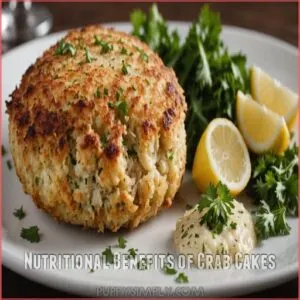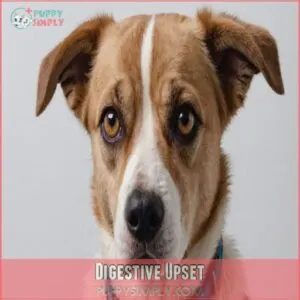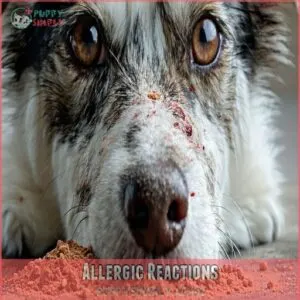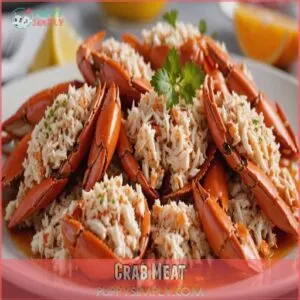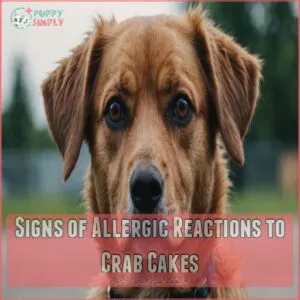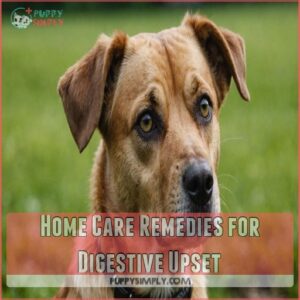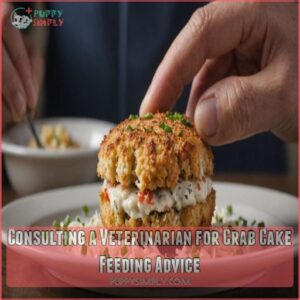This site is supported by our readers. We may earn a commission, at no cost to you, if you purchase through links.
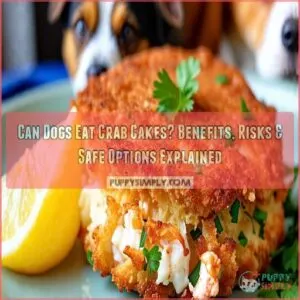 It’s a tricky question!
It’s a tricky question!
While plain, cooked crab meat itself isn’t toxic, crab cakes often contain ingredients that aren’t good for your pup.
Onions, garlic, and butter are common culprits.
Those can upset their tummy.
So, you shouldn’t give your dog crab cakes.
Stick to dog-friendly treats.
If you’re wondering whether your dog can enjoy a tasty treat, consider the dangers of certain foods like rib bones and choking hazards. Want to know what is safe and delicious for your furry friend?
Read on to discover some surprisingly tasty alternatives.
Table Of Contents
- Key Takeaways
- Nutritional Benefits of Crab Cakes
- Risks of Feeding Crab Cakes to Dogs
- Safe Ingredients in Crab Cakes for Dogs
- Preparing Crab Cakes Safely for Dogs
- Alternatives to Crab Cakes for Dogs
- Signs of Allergic Reactions to Crab Cakes
- Home Care Remedies for Digestive Upset
- Consulting a Veterinarian for Crab Cake Feeding Advice
- Frequently Asked Questions (FAQs)
- What happens if my dog eats crab?
- What seafood can dogs eat?
- Is imitation crab meat safe for dogs?
- Are dogs allowed to eat crab sticks?
- Can dogs eat crab cakes with spices?
- How often can dogs have crab cakes?
- Are there health benefits in crab cakes for dogs?
- Do crab cakes affect a dogs coat health?
- Can puppies safely eat crab cakes?
- Conclusion
Key Takeaways
- Don’t feed your dog crab cakes because they often contain ingredients like onions and garlic that can upset their stomach.
- While plain crab meat is a safe source of lean protein and omega-3 fatty acids for dogs, always cook it thoroughly and watch for allergies.
- For a safer diet, choose human-grade dog food or simple treats like cooked fish or bell peppers that avoid harmful additives.
- When introducing fish into your dog’s diet, consider the benefits of fish like salmon and sardines, which provide high-quality protein and omega-3 fatty acids, learn more about safe fish options. Consult your vet before introducing new foods to your dog’s diet to ensure health and safety.
Nutritional Benefits of Crab Cakes
Crab cakes offer nutritional benefits through their high protein content, essential for your dog’s muscle health. They also contain vitamins, minerals, and omega-3 fatty acids that can support overall well-being.
Protein Content
Crab cakes can be a tasty treat for your dog, offering a decent protein source.
This lean protein, known as crab protein, supports muscle maintenance and energy.
You can even find products specifically formulated with dog crab cake protein to mix things up in their diet.
But, like all good things, moderation is key.
Consider crab as a tasty alternative source to mix things up, but don’t rely on it solely for your dog’s nutritional value.
Vitamins and Minerals
Your dog’s diet benefits from a good balance of minerals and vitamins, found in crab.
It packs a punch with B12, zinc, and selenium, which are key helpers in energy boost and immune support.
To keep your dog healthy and happy, here’s a checklist:
- With other foods.
- Monitor for allergies.
- Control portions.
- Cook thoroughly.
Omega-3 Fatty Acids
When you’re treating your furry friend with crab cakes, those Omega-3 fatty acids can’t be overlooked.
They’re superheroes for dog coat health, brain function, and joint health.
Think of them as nature’s little helpers, complementing other Omega-3 sources like fish oil supplements.
Always make sure to practice moderation, though, to keep your pup safe and happy while reaping these benefits.
Risks of Feeding Crab Cakes to Dogs
Feeding crab cakes to your dog may lead to digestive upset due to high cholesterol and sodium content.
Additionally, there’s a risk of allergic reactions, so it’s wise to proceed with caution.
Digestive Upset
Giving your dog crab cakes? Keep an eye out for tummy troubles. Digestive upset is a possibility.
Here’s what to watch for:
- Soft stools or diarrhea.
- Vomiting.
- Bloating.
If you see these signs, reduce or stop the crab cakes. Always check with your vet about your dog’s diet.
Allergic Reactions
Dogs might experience crab allergies, which can sneak up like an unexpected guest.
Look for signs of allergy such as itching, swelling, or digestive upset.
Common allergens in crab cakes include additives and seasonings.
To play it safe, consider dog allergy tests and allergy management options.
Always consult your vet to make sure you’re making the best choice for your furry friend.
Safe Ingredients in Crab Cakes for Dogs
You can enjoy peace of mind knowing that some ingredients in crab cakes are safe for your dog.
Crab meat and red bell pepper provide nutrition without the usual risks found in other ingredients.
Crab Meat
Crab meat, rich in vitamins and minerals like B12 and omega-3 fatty acids, can be a safe treat for dogs when prepared correctly.
It’s a lean protein source full of vitamins.
However, some dogs might be allergic, so keep an eye out.
You can find dog-safe crab cake recipes and ingredients online, like those available at a trusted online retailer.
Cook thoroughly to avoid parasites.
No shells please; they’re a choking hazard.
Introduce crab meat gradually.
Store cooked crab meat properly to maintain freshness.
Red Bell Pepper
While crab meat gets all the attention, red bell pepper is a quiet star.
This colorful veggie offers dogs vitamins and antioxidants, helping boost their immune system, and is actually a nutritious snack option.
You don’t need much—a small piece is enough.
Cook it to soften or serve raw for a crunchy treat.
Remember, start slow to avoid any red bell pepper allergy surprises.
Preparing Crab Cakes Safely for Dogs
When preparing crab cakes for your dog, make sure you cook the crab meat thoroughly to avoid health risks.
Also, make sure there are no raw or shelled pieces in your homemade treats to keep your pet safe.
Cooking Methods
Turning crab cakes into a dog-friendly snack isn’t rocket science.
Stick to methods like steaming, baking, grilling, or air-frying while keeping things simple.
These methods skip the extra grease from frying and make the treat easier on your pup’s tummy.
Remember, your furry friend’s taste buds appreciate the effort, so keep things tasty and safe with these cooking styles.
Avoiding Raw or Shelled Crab
Never give your dog raw or shelled crab.
Raw crab carries parasite risks.
Sharp shell fragments can cause serious injuries.
Thorough cooking is essential for shell safety.
If you’re unsure, always opt for safer substitution options.
Better safe than sorry!
A vet consultation can provide personalized advice.
Alternatives to Crab Cakes for Dogs
If you’re looking for alternatives to crab cakes for your dog, consider fresh, human-grade dog food. It provides healthy and balanced nutrition while meeting your dog’s specific dietary needs.
Fresh, Human-Grade Dog Food
Cook crab cakes thoroughly for dogs, but why not opt for fresh, human-grade dog food that can even provide benefits like improved skin and coat health by offering a diet rich in essential fatty acids and enzymes, found in some Raw Dog Food Diets.
Safety and nutrition are key.
Choosing these factors gives you:
- Ingredient Transparency: Know exactly what’s in it.
- Brand Reputation: Trustworthy brands offer reliability.
- Cost Comparison: More wallet-friendly than expected!
Prioritize these factors for a wagging tail and tummy.
Healthy and Balanced Nutrition Options
Okay, so you’re thinking about fresh, human-grade dog food.
Now, how about balancing your dog’s nutrition needs?
You can explore dog food brands, try homemade dog food, or provide healthy treats for dogs.
| Option | Pros | Cons |
|---|---|---|
| Dog Food Brands | Balanced nutrition | Might be costly |
| Homemade Food | Control ingredients | Time-consuming |
| Treats | Easy to serve | Potential for overfeeding |
This mix helps them meet their nutritional needs for weight management.
Signs of Allergic Reactions to Crab Cakes
It’s important to watch for signs of allergies if your dog tries crab cakes. Common symptoms include skin irritation and digestive issues, which may require veterinary attention.
Skin Irritation
If your dog gets skin irritation from crab cakes, it might be due to crab shell fragments causing skin allergies.
Watch for scratching or redness.
Different dog breeds react differently, so stay alert.
For effective dog skin relief treatments, consider using products that cater to your pet’s specific needs dog skin relief options.
Topical treatments and grooming tips can help soothe any discomfort.
It’s wise to check with your vet about specific reactions and the best care for your dog.
Digestive Issues
After dealing with skin irritation, digestive issues can also pop up when your dog tries crab cakes.
You might notice signs like loose stools or gassy tummies, hinting at crab allergies or food sensitivities.
Which can be similar to symptoms of sensitive stomachs in dogs, often caused by food intolerances or dietary deficiencies, as seen in cases requiring sensitive stomach dog food.
Keep an eye out for these cues to make sure your dog’s digestive health is in good shape.
It’s like giving your dog digestive enzymes to ease tummy troubles and prevent IBS in dogs.
Home Care Remedies for Digestive Upset
Digestive upset can be worrying. Simple home remedies like a bland chicken and rice diet, plain canned pumpkin, and plenty of fresh water can often help soothe your dog’s tummy.
Chicken and Rice Diet
Feeling worried about your pup’s tummy troubles?
The Chicken and Rice Diet is a gentle remedy that might help, especially for dogs experiencing diarrhea symptoms.
Just cook some bland chicken with plain rice.
This easy meal soothes upset stomachs and is gentle on digestion.
Feed your dog small portions for a few days, then gradually reintroduce their regular food.
Always check with your vet to make sure it’s right for your furry friend.
Use of Canned Pumpkin
Bothered by your dog’s tummy troubles?
Canned pumpkin can be a gentle hero!
Rich in fiber, it helps dogs with diarrhea and constipation alike.
Just mix a spoonful into their food.
Its high water content aids digestion, while its appeal makes it easy to serve.
So, why not let this humble veggie do the work?
Hydration Tips
Keeping your dog hydrated is key when they’ve digestive issues.
Watch out for changes in their drinking habits.
Make sure water bowls are clean and always filled.
Look for dehydration signs, like sunken eyes or dry gums.
Offer fresh water from reliable sources.
Maintaining proper hydration levels helps your furry friend feel better and recover faster.
Consulting a Veterinarian for Crab Cake Feeding Advice
When you’re considering giving your dog crab cakes, it’s best to get advice from a veterinarian to make sure safe feeding.
They can help you create a personalized dietary plan and watch for any adverse reactions in your pet.
Personalized Dietary Plans
If your dog enjoys crab cakes, you might wonder about a safe dietary plan.
Chat with a vet to tailor a plan focused on dog food allergies, breed-specific needs, weight management, and digestive health.
Consider your dog’s life stage; puppies and seniors have different needs.
This helps your dog enjoy treats without upsetting their diet balance.
Monitoring for Adverse Reactions
When introducing crab cakes, watch for signs of allergy or food sensitivity.
Dogs can react differently, so keep an eye on any dog reaction timeline.
Key indicators include:
- Vomiting or diarrhea
- Itching or skin irritation
- Loss of appetite
- Swelling or hives
- Lethargy or discomfort
Discuss any concerns with a vet consultation for specific advice.
Frequently Asked Questions (FAQs)
What happens if my dog eats crab?
Imagine your dog sneaking a leftover crab leg.
While crab’s not toxic, watch for tummy issues or allergies.
Cooked is best, as raw crab might carry parasites.
It’s wise to check with your vet for guidance.
What seafood can dogs eat?
Similarly, you can also consider adding other seafood like oysters as a protein source, but make sure they are properly cooked. You can safely feed your dog cooked fish like salmon and whitefish.
You can also safely feed them cooked shellfish like shrimp, crab, and lobster.
Scallops, like other seafood, are fine for dogs in moderation, but be sure to check for allergic reactions, as with any new food, including scallops for dogs. Always cook seafood thoroughly and check for allergic reactions.
Avoid tails and shells.
No seasonings.
Is imitation crab meat safe for dogs?
Feeding dogs imitation crab meat is risky, like serving them a mystery stew.
It’s overly processed, full of additives, and not nutritious.
While a tiny bit won’t harm, it’s best to stick with healthier options.
Are dogs allowed to eat crab sticks?
Crab sticks, made from processed fish and additives, aren’t ideal for dogs.
They contain sugar, sodium, and other ingredients that can upset your dog’s stomach.
While a tiny amount mightn’t harm, it’s better avoided.
Can dogs eat crab cakes with spices?
Like a delicious but risky treat, crab cakes with spices aren’t ideal for dogs.
Spices and additives can upset their stomachs.
Stick to plain, cooked crab meat and consult your vet for safe dietary options.
How often can dogs have crab cakes?
Treat your pup to crab cakes sparingly.
A tiny bit, maybe once a month, is okay.
Always check ingredients for things like onions or garlic, which are no-nos for dogs.
Too much can upset their tummies.
Are there health benefits in crab cakes for dogs?
Did you know crab meat has omega-3s?
However, crab cakes for dogs often contain spices and breadcrumbs that aren’t dog-friendly.
While crab offers protein and vitamins, the other ingredients in crab cakes outweigh their benefits for pups.
Do crab cakes affect a dogs coat health?
Crab cakes can benefit a dog’s coat health due to omega-3 fatty acids, which help maintain a shiny coat.
However, the additives and seasonings in crab cakes might pose risks, so consult your vet before offering them.
Can puppies safely eat crab cakes?
Giving crab cakes to puppies is like walking a tightrope.
They contain spices and potential allergens harmful to pups.
Stick to plain, cooked proteins and gradually introduce new foods to guarantee their safety and health.
Conclusion
The decision to feed your dog crab cakes symbolizes a balance between treating them and ensuring their health.
While crab cakes may seem appealing, the risks often outweigh the benefits for dogs.
Ingredients like onions pose digestive threats.
If you’re asking, "Can dogs eat crab cakes?" it’s safer to stick to dog-specific treats.
Opt for alternatives that match your pup’s nutritional needs, ensuring they stay happy and healthy.
Always consult a vet if you’re unsure about their diet.

